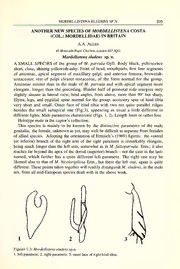
Another new species of Mordellistena Costa (Col.: Mordellidae) in Britain PDF
Preview Another new species of Mordellistena Costa (Col.: Mordellidae) in Britain
MORDELLISTENAELUDENSSP.N. 205 ANOTHER NEW SPECIES OFMORDELLISTENA COSTA (COL.: MORDELLIDAE) IN BRITAIN A.A, Allen 49MontcalmRoad,Charlton,LondonSE78QG. Mordellistenaeludens sp. n. A SMALL SPECIES of the group of M. parvula Gyll. Body black, pubescence short, close, shining yellowish-ashy. Front of head, mouthparts, first four segments of antennae, apical segment of maxillary palpi, and anterior femora, brownish- testaceous; rest of palpi clearer testaceous, of the form normal for the group. Antennae stouter than in the male of M. parvula and with apical segment more elongate, longer than the preceding. Hinder half of pronotal side-margins only slightly sinuate in lateral view; hind angles, from above, more than 90° but sharp. Elytra, legs, and pygidial spine normal for the group; accessory spur of hind tibia very short and small. Outer face of hind tibia with two not quite parallel ridges besides the small subapical one (Fig.3), appearing as usual a little different in differentlights. Maleparamerescharateristic (Figs. 1, 2). Length 3mmorratherless. Holotypemale inthecaptor'scollection. This species is mainly to be known by the distinctive parameres of the male genitalia; the female, unknownas yet, may wellbe difficultto separate from females ofallied species. Adopting the orientation ofErmisch's (1969) figures: the ventral (or inferior) branch of the right arm of the right paramere is remarkably elongate, M being much longer than the left arm, somewhat as in .falsoparvula Erm.; it also reaches farbeyond the apex ofthe dorsal (superior) branch-not the case in the last- named, which further has a quite different left paramere. The right one may be likened also to that ofM. bicoloripilosa Erm., but there the left one, again is quite different. Thesepoints taken togetherwillreadily distinguishM. eludens, in themale sex, fromallmid-European speciesdealtwithintheabove work. 1 Figures 1-3:Mordellistenaeludenssp.n. 1. leftparamere; 2.rightparamere; 3.outerfaceofrighthindtibia. 1 206 ENTOMOLOGIST'SRECORD,VOL. 11 25.ix.1999 The unique specimen was takenby general sweeping onopenflowery groundon Mount Caburn, a chalk hill two miles south-east of Lewes in East Sussex, on 19.vi.l993, by MrR.A. Jones, and submitted to me. Much effortby him and MrP. J. Hodge at and near the spot has so far failed to yield further material - whence the name I have chosen. Attempts to contact the Mordellistena specialist in Prague, Dr Jan Horak, in connection with this insect, have unfortunately met with no success. The occurrence of yet another member of this genus in England should not occasion great surprise. I know of a further species, likewise apparently unique as British, notyetpublished. Reference Ermisch,K., 1969.InFreude,H.,Harde,K.W.&Lohse,G.A.,DieKdferMitteleuropas: 175,177. Goecke&Evers,Krefeld. Some observations on pigment stability in the wing markings of Graphium weiskei(Ribbe) (Lep.: Papilionidae) Hanging in a display case on my wall are two specimens ofGraphium weiskei, both taken by myself in Chimbu Province, Papua New Guinea in 1976. Originally these were easily discernible as being of two varieties; one normal and the other having the pink colour ofthe sub-basal patch replaced by pale-blue. Both ofthese varieties are illustrated in Parsons (1999. The Butterflies ofPupua New Guinea: Their systematics and biology. Academic Press, London). Now they are indistinguishable from each other as, over a period of about ten years, the blue in the one and the mauve in the other have oxidised to bright pink so that only two colours remain in thewing spots andsub-basalpatch-greenandpink. Haugum and Samson (1981. Notes on Graphium weiskei. Lepid. Gp. of 1968 Newsl, (Suppl.) 1-12) postulated that the colour forms of G. weiskei probably resultedfrom the "degree ofphotochemical oxidation (orsimilarinfluencing factors affecting the live insect)". There now would appear to be three main objections to thathypothesis, namely: a) Colourvarieties are alreadyapparentinfreshimagines (Parsons loc. cit.) b) Colour changes require a long time to occurphotochemically, (albeit in dead G. weiskei) c) suchamechanism wouldappeartorequirebluetobetheoriginalcolourofthe pigment on emergence and would, in the case ofthe two varieties considered here, make the blue form much more common than indeed it is. (I have estimatedits frequencyinthewildtobeintheorderof0.001.) -J.B. JOBE, 13 WillowWalk,Ripon, NorthYorkshireHG42LS.
